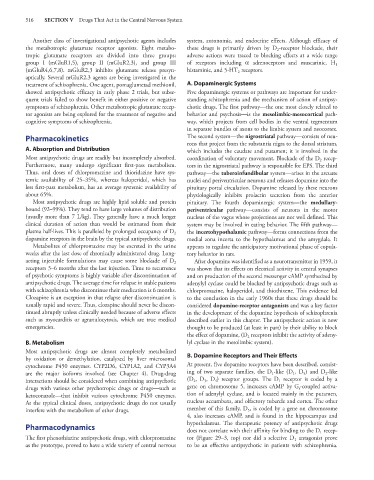Page 530 - Basic _ Clinical Pharmacology ( PDFDrive )
P. 530
516 SECTION V Drugs That Act in the Central Nervous System
Another class of investigational antipsychotic agents includes system, autonomic, and endocrine effects. Although efficacy of
the metabotropic glutamate receptor agonists. Eight metabo- these drugs is primarily driven by D -receptor blockade, their
2
tropic glutamate receptors are divided into three groups: adverse actions were traced to blocking effects at a wide range
group I (mGluR1,5), group II (mGluR2,3), and group III of receptors including α adrenoceptors and muscarinic, H
1
(mGluR4,6,7,8). mGluR2,3 inhibits glutamate release presyn- histaminic, and 5-HT receptors.
2
aptically. Several mGluR2,3 agents are being investigated in the
treatment of schizophrenia. One agent, pomaglumetad methionil, A. Dopaminergic Systems
showed antipsychotic efficacy in early phase 2 trials, but subse- Five dopaminergic systems or pathways are important for under-
quent trials failed to show benefit in either positive or negative standing schizophrenia and the mechanism of action of antipsy-
symptoms of schizophrenia. Other metabotropic glutamate recep- chotic drugs. The first pathway—the one most closely related to
tor agonists are being explored for the treatment of negative and behavior and psychosis—is the mesolimbic-mesocortical path-
cognitive symptoms of schizophrenia. way, which projects from cell bodies in the ventral tegmentum
in separate bundles of axons to the limbic system and neocortex.
Pharmacokinetics The second system—the nigrostriatal pathway—consists of neu-
rons that project from the substantia nigra to the dorsal striatum,
A. Absorption and Distribution which includes the caudate and putamen; it is involved in the
Most antipsychotic drugs are readily but incompletely absorbed. coordination of voluntary movement. Blockade of the D recep-
2
Furthermore, many undergo significant first-pass metabolism. tors in the nigrostriatal pathway is responsible for EPS. The third
Thus, oral doses of chlorpromazine and thioridazine have sys- pathway—the tuberoinfundibular system—arises in the arcuate
temic availability of 25–35%, whereas haloperidol, which has nuclei and periventricular neurons and releases dopamine into the
less first-pass metabolism, has an average systemic availability of pituitary portal circulation. Dopamine released by these neurons
about 65%. physiologically inhibits prolactin secretion from the anterior
Most antipsychotic drugs are highly lipid soluble and protein pituitary. The fourth dopaminergic system—the medullary-
bound (92–99%). They tend to have large volumes of distribution periventricular pathway—consists of neurons in the motor
(usually more than 7 L/kg). They generally have a much longer nucleus of the vagus whose projections are not well defined. This
clinical duration of action than would be estimated from their system may be involved in eating behavior. The fifth pathway—
plasma half-lives. This is paralleled by prolonged occupancy of D the incertohypothalamic pathway—forms connections from the
2
dopamine receptors in the brain by the typical antipsychotic drugs. medial zona incerta to the hypothalamus and the amygdala. It
Metabolites of chlorpromazine may be excreted in the urine appears to regulate the anticipatory motivational phase of copula-
weeks after the last dose of chronically administered drug. Long- tory behavior in rats.
acting injectable formulations may cause some blockade of D After dopamine was identified as a neurotransmitter in 1959, it
2
receptors 3–6 months after the last injection. Time to recurrence was shown that its effects on electrical activity in central synapses
of psychotic symptoms is highly variable after discontinuation of and on production of the second messenger cAMP synthesized by
antipsychotic drugs. The average time for relapse in stable patients adenylyl cyclase could be blocked by antipsychotic drugs such as
with schizophrenia who discontinue their medication is 6 months. chlorpromazine, haloperidol, and thiothixene. This evidence led
Clozapine is an exception in that relapse after discontinuation is to the conclusion in the early 1960s that these drugs should be
usually rapid and severe. Thus, clozapine should never be discon- considered dopamine-receptor antagonists and was a key factor
tinued abruptly unless clinically needed because of adverse effects in the development of the dopamine hypothesis of schizophrenia
such as myocarditis or agranulocytosis, which are true medical described earlier in this chapter. The antipsychotic action is now
emergencies. thought to be produced (at least in part) by their ability to block
the effect of dopamine, (D receptors inhibit the activity of adeny-
2
B. Metabolism lyl cyclase in the mesolimbic system).
Most antipsychotic drugs are almost completely metabolized
by oxidation or demethylation, catalyzed by liver microsomal B. Dopamine Receptors and Their Effects
cytochrome P450 enzymes. CYP2D6, CYP1A2, and CYP3A4 At present, five dopamine receptors have been described, consist-
are the major isoforms involved (see Chapter 4). Drug-drug ing of two separate families, the D -like (D , D ) and D -like
1
2
5
1
interactions should be considered when combining antipsychotic (D , D , D ) receptor groups. The D receptor is coded by a
4
1
2
3
drugs with various other psychotropic drugs or drugs—such as gene on chromosome 5, increases cAMP by G -coupled activa-
s
ketoconazole—that inhibit various cytochrome P450 enzymes. tion of adenylyl cyclase, and is located mainly in the putamen,
At the typical clinical doses, antipsychotic drugs do not usually nucleus accumbens, and olfactory tubercle and cortex. The other
interfere with the metabolism of other drugs. member of this family, D , is coded by a gene on chromosome
5
4, also increases cAMP, and is found in the hippocampus and
Pharmacodynamics hypothalamus. The therapeutic potency of antipsychotic drugs
does not correlate with their affinity for binding to the D recep-
1
The first phenothiazine antipsychotic drugs, with chlorpromazine tor (Figure 29–3, top) nor did a selective D antagonist prove
1
as the prototype, proved to have a wide variety of central nervous to be an effective antipsychotic in patients with schizophrenia.

